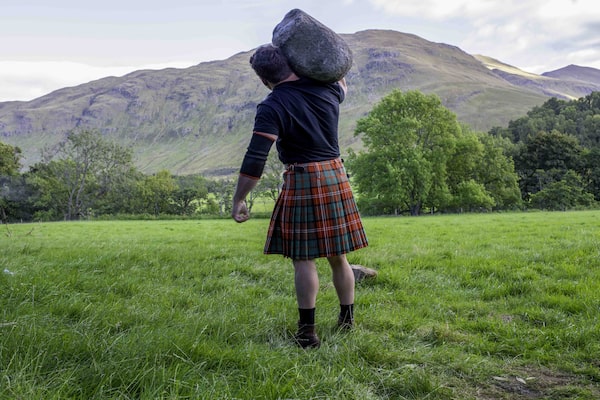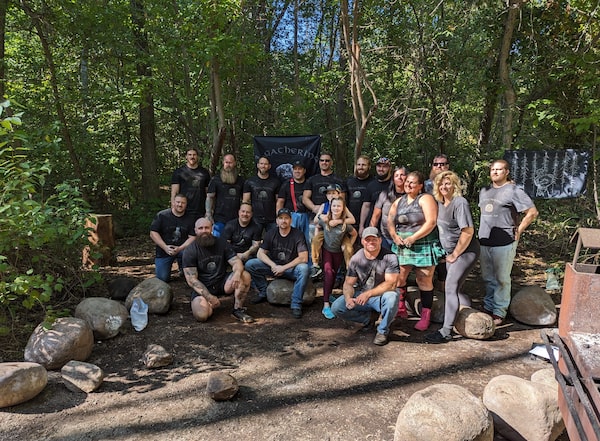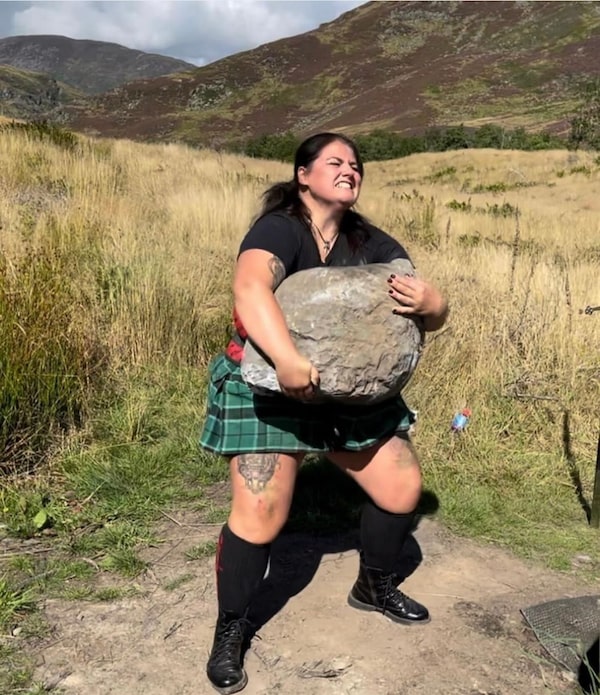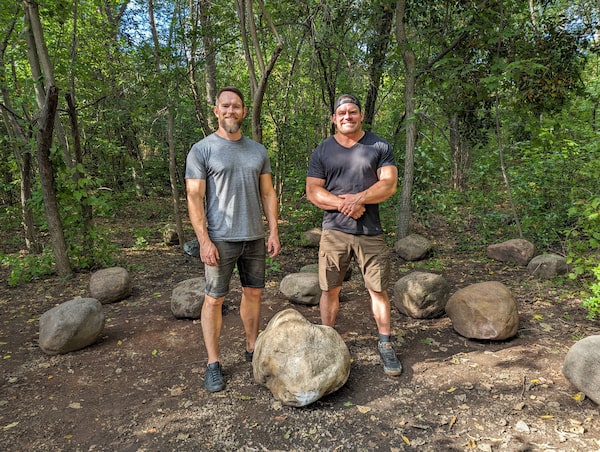
Stone lifters are creating a new community and a culture based around an ancient ritual of strength.Kerry Nisbet
In a dusty clearing in Sir Wilfrid Laurier Park, 10 kilometres from downtown Edmonton, 42-year-old Sarah Barbeau approaches a boulder as wide as her torso and tall enough to graze the bottom of her thighs. She places one bare foot in the dirt on each side of the stone and wraps her arms around it, enveloping it in a sort of brutal bear hug. Pressing her forearms into the smooth sides of the stone, she takes a deep inhale, squeezes the stone, and raises it from the ground, tugging it over her knees and into her lap. Sinking into a deep squat, she shifts the weight of the nearly 300-pound rock side to side, searching for the best angle to secure the hold. As she rises to stand, though, her grip begins to slip.
From the sidelines, Dave Nisbet lunges forward to help but quickly backs off. His job today is to make sure all athletes like Barbeau are safe, but it’s also to give them a chance to move an object that once seemed immovable. So he gives her space to wrestle with the rock.
As Barbeau continues her pursuit, a crowd of athletes who have gathered for the second annual gathering held by Edmonton Stones of Strength shout words of encouragement while they wait to make their own attempts. Dave, 38, and his brother Dale, 36, founded this collective in 2022 with the goal of creating a new community and a culture based around an ancient ritual of strength.
Hugging rocks might seem like an odd way to get fit, but when most of the fitness industry is focused on shortcuts, stone lifting presents an opportunity to challenge your limits in a refreshingly elemental way. For the Nisbet brothers and a growing community of stone lifters, it’s also a way to connect with their ancestors by participating in their cultural traditions.

The second annual gathering hosted by Edmonton Stones of Strength, at Sir Wilfrid Laurier Park, Edmonton.Troy Pereira/Supplied
An ancient practice rediscovered
Stone lifting has been part of the fabric of communities across the globe for centuries, with records in countries including Japan, India, Spain, Scotland, Ireland and Sweden. There are stories of stones hoisted in rituals of manhood (and in some cases, womanhood), in celebration of weddings, to determine someone’s fitness for a job and to honour the dead.
Because so much of stone-lifting history has been passed down through oral storytelling, a handful of enthusiasts are on a quest to find every stone with historical significance before their stories are lost to the passing of generations. In Ireland, David Keohan, known to the community as Indiana Stones, has found and documented more than 30 of the country’s lost stones. In Ohio, schoolteacher Sean Urquhart has become one of the foremost experts on historical stones, travelling to Scotland, Iceland, the Faroe Islands and Ireland to help rediscover and lift ancient stones, and sharing his research on social media.

Rebecca Innes lifts a 99kg (218lbs) stone called The Saddlin’ Mare in Crieff, Perth.Supplied
Ontario’s Rebecca Innes brought the first International Highland Games Federation Stones of Strength Women’s Division to Canada in 2023. Ryan Stewart, a stone history buff who has helped rediscover ancient stones in places such as Sweden and Iceland, founded Utah Stones of Strength with a similar mission to the Nisbet brothers and has spent the past six years researching a pair of Canadian stones that may prove to be among the oldest in North America.
A clever courtship and a fatal battle of strength
Stone lifting in Canada has been less highly publicized than in some countries, but the roots are centuries deep. Arvia’juaq National Historic Site, located on Arvia’juaq near the community of Arviat on the Northwest coast of Hudson Bay in Nunavut, is home to the arnaqatirjuarjugiik (Cousin Stones). As the story goes, two cousins were turned rivals when one tried to steal the other’s wife, and fought in a battle that ended with both of their deaths. “The rocks, as seen today, were placed when the competition became a feat of strength, each cousin lifting the rocks into place,” according to the Arvia’juaq and Qikiqtaarjuk Oral History Project.
In a 1993 edition of Inuktitut, writer Luke Suluk reports finding an inuksuk on the south shore of Sarvaqtuuq “that is said to have been taken up from the shore by one man who was apparently showing his strength to another man who wanted to take his wife.”
There are also stories of the Inuit using stones for games and cultural traditions.
Nova Scotia has a rich history of stone lifting as well, according to the University of Cape Breton’s research into eastern Nova Scotia and Cape Breton folklore. There’s the tale of a 300-pound stone being hurled over a barn in anger during a local wedding, and another in which a father challenged his daughter’s suitor to lift a 160-pound rock before he would offer his blessing. The clever suitor chipped 50 pounds off the rock with a chisel in the cover of night and easily hoisted it the next day.
Still, while historical stones in many parts of the world are easily found, mapped and available to be lifted, many of Canada’s historical stones are either unreachable or visited at the lifter’s own peril: the arnaqatirjuarjugiik stones rest on an uninhabited historical site favoured by hungry polar bears who swim over to feast on leftover whale carcasses.
Not every rock is a good rock
In 2022, the Nisbets decided to create their own, more easily accessible stone-lifting tradition in Edmonton. Dave had seen a documentary about Scotland’s stone-lifting history and was immediately drawn to it, in part because of his own Scottish ancestry. “It connected on so many levels,” he says. When he and Dale travelled to Scotland and he placed his hands on the same stones lifted hundreds of years ago, he felt an instant kinship with the ritual and his roots.
Once they had the idea to begin a new tradition, they had to find the right stones.

Dave and Dale Nisbet with 408-pound stone called The Devil’s Potato in Edmonton.Troy Pereira/Supplied
Some of the selection process is instinctual, Dave explains. “Think of a kid collecting rocks,” he says. “Not every rock you find is a ‘good’ rock. They have to be the right texture, a good shape. You don’t want a sharp one or a jagged one that’s going to tear you up. You want variance in types of stone because that’s what makes it interesting. Will it present a good challenge?”
They’ll find stones as small as 20 pounds for kids to attempt, while the bigger stones start at around 100 pounds and continue into the 400s.
Naming your stone is a rite of passage. Among the Edmonton Stones of Strength are the 325-pound Nisbet Stone, 380-pound Éigéillí (a Gaelic word meaning “closer to a beast than a man, barely human”), and a 408-pound monster called the Devil’s Potato.
Finding your own strength
The banjo music emanating from a nearby speaker swells, the drums now kicking in. Screams of “you got this” and “Up! Up!” grow louder as Barbeau regrips the rock and slowly straightens her legs to rise. When she has finally made it to standing with the stone clasped tightly to her chest, she releases her grip and allows it to land with a soft thud and a cloud of dust. Her expression shifts from total focus to a beaming smile.
Moments like this are why the Nisbet brothers do this. Maybe we don’t need to lift rocks to prove our worth as a suitor or ascend to manhood or womanhood, but in our increasingly tech-dominated world, there’s power in coming together with your community to use your strength for something that is powerful and so basic at the same time.
Dave hopes that as word spreads of the practice, more people will be open to challenging themselves.
“There’s a lot of things you learn about yourself from pushing yourself to the limit,” he says. “If our stones are a way that you can better yourself and learn about yourself, then that makes us really happy. What we’ve set up can maybe continue on. Maybe 50 years from now people go, ‘Hey this is where those old dudes used to lift.’ And maybe it’ll start something new.”
Alyssa Ages is a journalist and the author of Secrets of Giants: A Journey to Uncover the True Meaning of Strength. She is also a strongman competitor and endurance athlete, as well as a former personal trainer and group fitness instructor.